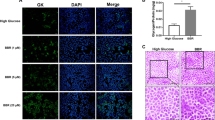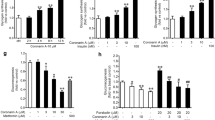Abstract
This work was aimed to investigate the action mechanism of berberine (BBR) on gluconeogenesis. The effects of BBR were examined in rat primary hepatocytes and confirmed in vivo in spontaneous diabetic rats. Protein levels were assessed by Western blot. Immunofluorescence staining was utilized for visualizing protein expression, while qRT-PCR helped for the determination of gene expression at the mRNA level. Besides, cGMP concentration was measured using ELISA, whereas NO level was assessed by spectrophotometry. BBR inhibited gluconeogenesis by downregulating G6Pase and PEPCK via inhibition of CREB phosphorylation. Moreover, BBR enhanced NO and cGMP concentrations, leading to the activation of the NO/cGMP/PKG signaling via activating AKT1/MAPK axis. The in vivo experiments were consistent with the findings obtained in vitro. Hence, BBR represents a drug candidate for diabetic patients and its mechanism of action may be driven via the AKT/MAPK/NO/cGMP/PKG pathway.










Similar content being viewed by others
Data availability
The data that support the findings of this study are available from the corresponding author upon reasonable request.
References
Costello KR, Schones DE (2018) Chromatin modifications in metabolic disease: potential mediators of long-term disease risk. Wiley Interdiscip Rev Syst Biol Med 10(4):e1416. https://doi.org/10.1002/wsbm.1416
Xu X, Yi H, Wu J, Kuang T, Zhang J, Li Q, Du H, Xu T, Jiang G, Fan G (2021) Therapeutic effect of berberine on metabolic diseases: both pharmacological data and clinical evidence. Biomed Pharmacother 133:110984. https://doi.org/10.1016/j.biopha.2020.110984
Saeedi P, Petersohn I, Salpea P, Malanda B, Karuranga S, Unwin N, Colagiuri S, Guariguata L, Motala AA, Ogurtsova K, Shaw JE, Bright D, Williams R (2019) Global and regional diabetes prevalence estimates for 2019 and projections for 2030 and 2045: results from the international diabetes federation diabetes atlas, 9(th) edition. Diabetes Res Clin Pract 157:107843. https://doi.org/10.1016/j.diabres.2019.107843
Beagley J, Guariguata L, Weil C, Motala AA (2014) Global estimates of undiagnosed diabetes in adults. Diabetes Res Clin Pract 103(2):150–160. https://doi.org/10.1016/j.diabres.2013.11.001
Punthakee Z, Goldenberg R, Katz P (2018) Definition, classification and diagnosis of diabetes, prediabetes and metabolic syndrome. Can J Diabetes 42(Suppl 1):S10-s15. https://doi.org/10.1016/j.jcjd.2017.10.003
Zhang M, Chen L (2012) Berberine in type 2 diabetes therapy: a new perspective for an old antidiarrheal drug? Acta Pharm Sinica B 2(4):379–386. https://doi.org/10.1016/j.apsb.2012.06.004
Xu M, Xiao Y, Yin J, Hou W, Yu X, Shen L, Liu F, Wei L, Jia W (2014) Berberine promotes glucose consumption independently of AMP-activated protein kinase activation. PLoS ONE 9(7):e103702. https://doi.org/10.1371/journal.pone.0103702
Patel P (2021) A bird’s eye view on a therapeutically ‘wonder molecule’: Berberine. Phytomed Plus 1(3):100070. https://doi.org/10.1016/j.phyplu.2021.100070
Yin J, Ye J, Jia W (2012) Effects and mechanisms of berberine in diabetes treatment. Acta Pharm Sinica B 2(4):327–334. https://doi.org/10.1016/j.apsb.2012.06.003
Di S, Han L, An X, Kong R, Gao Z, Yang Y, Wang X, Zhang P, Ding Q, Wu H, Wang H, Zhao L, Tong X (2021) In silico network pharmacology and in vivo analysis of berberine-related mechanisms against type 2 diabetes mellitus and its complications. J Ethnopharmacol 276:114180. https://doi.org/10.1016/j.jep.2021.114180
Zhang B, Pan Y, Xu L, Tang D, Dorfman RG, Zhou Q, Yin Y, Li Y, Zhou L, Zhao S, Zou X, Wang L, Zhang M (2018) Berberine promotes glucose uptake and inhibits gluconeogenesis by inhibiting deacetylase SIRT3. Endocrine 62(3):576–587. https://doi.org/10.1007/s12020-018-1689-y
Manning BD, Cantley LC (2007) AKT/PKB signaling: navigating downstream. Cell 129(7):1261–1274. https://doi.org/10.1016/j.cell.2007.06.009
Kousteni S (2012) FoxO1, the transcriptional chief of staff of energy metabolism. Bone 50(2):437–443. https://doi.org/10.1016/j.bone.2011.06.034
Cross DA, Alessi DR, Cohen P, Andjelkovich M, Hemmings BA (1995) Inhibition of glycogen synthase kinase-3 by insulin mediated by protein kinase B. Nature 378(6559):785–789. https://doi.org/10.1038/378785a0
Huang X, Liu G, Guo J, Su Z (2018) The PI3K/AKT pathway in obesity and type 2 diabetes. Int J Biol Sci 14(11):1483–1496. https://doi.org/10.7150/ijbs.27173
Bengal E, Aviram S, Hayek T (2020) p38 MAPK in glucose metabolism of skeletal muscle: beneficial or harmful? Int J Mol Sci 21(18):6480. https://doi.org/10.3390/ijms21186480
Fang P, Sun Y, Gu X, Shi M, Bo P, Zhang Z, Bu L (2019) Baicalin ameliorates hepatic insulin resistance and gluconeogenic activity through inhibition of p38 MAPK/PGC-1α pathway. Phytomedicine 64:153074. https://doi.org/10.1016/j.phymed.2019.153074
Tian X, Liu F, Li Z, Lin Y, Liu H, Hu P, Chen M, Sun Z, Xu Z, Zhang Y, Han L, Zhang Y, Pan G, Huang C (2019) Enhanced anti-diabetic effect of berberine combined with timosaponin B2 in Goto-Kakizaki rats, associated with increased variety and exposure of effective substances through intestinal absorption. Front Pharmacol 10:19–19. https://doi.org/10.3389/fphar.2019.00019
Almani SA, Memon IA, Shaikh TZ, Khoharo HK, Ujjan I (2017) Berberine protects against metformin-associated lactic acidosis in induced diabetes mellitus. Iran J Basic Med Sci 20(5):511–515. https://doi.org/10.22038/IJBMS.2017.8675
Mata-Torres G, Andrade-Cetto A, Espinoza-Hernández FA, Cárdenas-Vázquez R (2020) Hepatic glucose output inhibition by Mexican plants used in the treatment of type 2 diabetes. Front Pharmacol 11:215. https://doi.org/10.3389/fphar.2020.00215
Xie W, Ye Y, Feng Y, Xu T, Huang S, Shen J, Leng Y (2018) Linderane suppresses hepatic gluconeogenesis by inhibiting the cAMP/PKA/CREB pathway through indirect activation of PDE 3 via ERK/STAT3. Front Pharmacol 9:476. https://doi.org/10.3389/fphar.2018.00476
Wang Y, Zhou X, Zhao D, Wang X, Gurley EC, Liu R, Li X, Hylemon PB, Chen W, Zhou H (2020) Berberine inhibits free fatty acid and LPS-induced inflammation via modulating ER stress response in macrophages and hepatocytes. PLoS ONE 15(5):e0232630–e0232630. https://doi.org/10.1371/journal.pone.0232630
Li M, Dang Y, Li Q, Zhou W, Zuo J, Yao Z, Zhang L, Ji G (2019) Berberine alleviates hyperglycemia by targeting hepatic glucokinase in diabetic db/db mice. Sci Rep 9(1):8003. https://doi.org/10.1038/s41598-019-44576-7
Kalyanaraman H, Schwaerzer G, Ramdani G, Castillo F, Scott BT, Dillmann W, Sah RL, Casteel DE, Pilz RB (2018) Protein kinase G activation reverses oxidative stress and restores osteoblast function and bone formation in male mice with type 1 diabetes. Diabetes 67(4):607–623. https://doi.org/10.2337/db17-0965
Hu X, Feng Y, Liu X, Zhao XF, Yu JH, Yang YS, Sydow-Bäckman M, Hörling J, Zierath JR, Leng Y (2007) Effect of a novel non-thiazolidinedione peroxisome proliferator-activated receptor alpha/gamma agonist on glucose uptake. Diabetologia 50(5):1048–1057. https://doi.org/10.1007/s00125-007-0622-3
Chen QM, Xie MZ (1986) Studies on the hypoglycemic effect of Coptis chinensis and berberine. Yao Xue Xue Bao 21(6):401–406
Quinn PG, Yeagley D (2005) Insulin regulation of PEPCK gene expression: a model for rapid and reversible modulation. Curr Drug Targets Immune Endocr Metabol Disord 5(4):423–437. https://doi.org/10.2174/156800805774912962
Mues C, Zhou J, Manolopoulos KN, Korsten P, Schmoll D, Klotz LO, Bornstein SR, Klein HH, Barthel A (2009) Regulation of glucose-6-phosphatase gene expression by insulin and metformin. Horm Metab Res 41(10):730–735. https://doi.org/10.1055/s-0029-1225360
Hill MJ, Suzuki S, Segars JH, Kino T (2016) CRTC2 is a coactivator of GR and couples GR and CREB in the regulation of hepatic gluconeogenesis. Mol Endocrinol 30(1):104–117. https://doi.org/10.1210/me.2015-1237
Herzig S, Long F, Jhala US, Hedrick S, Quinn R, Bauer A, Rudolph D, Schutz G, Yoon C, Puigserver P, Spiegelman B, Montminy M (2001) CREB regulates hepatic gluconeogenesis through the coactivator PGC-1. Nature 413(6852):179–183. https://doi.org/10.1038/35093131
He L, Sabet A, Djedjos S, Miller R, Sun X, Hussain MA, Radovick S, Wondisford FE (2009) Metformin and insulin suppress hepatic gluconeogenesis through phosphorylation of CREB binding protein. Cell 137(4):635–646. https://doi.org/10.1016/j.cell.2009.03.016
Bassot A, Chauvin MA, Bendridi N, Ji-Cao J, Vial G, Monnier L, Bartosch B, Alves A, Cottet-Rousselle C, Gouriou Y, Rieusset J, Morio B (2019) Regulation of mitochondria-associated membranes (MAMs) by NO/sGC/PKG participates in the control of hepatic insulin response. Cells 8(11):1319. https://doi.org/10.3390/cells8111319
Zhang N, Liu X, Zhuang L, Liu X, Zhao H, Shan Y, Liu Z, Li F, Wang Y, Fang J (2020) Berberine decreases insulin resistance in a PCOS rats by improving GLUT4: dual regulation of the PI3K/AKT and MAPK pathways. Regul Toxicol Pharmacol 110:104544. https://doi.org/10.1016/j.yrtph.2019.104544
Funding
This work was supported by the Budget projects of Shanghai University of traditional Chinese medicine [Grant Number 18LK063], the Shanghai Key Medical Specialities [Grant Number ZK2019B16] and the Clinical Characteristics of Health System in Putuo District, Shanghai [Grant Number 2020tszk01].
Author information
Authors and Affiliations
Contributions
ML, YW and YJ contributed to the manuscript writing, study design and data analysis. CZ, HW, WS and LC contributed to the drafting of the manuscript. TL and LL supervised the work and designed the study and manuscript writing. All the authors have read and approved the final version to be published.
Corresponding authors
Ethics declarations
Competing interests
The authors declare no competing interests.
Competing interest
The authors have no relevant financial or non-financial interest to disclose.
Ethical approval
All procedures involving animal studies were carried out with respect to the animal care guidelines and ethical committee approval from Shanghai Putuo Hospital affiliated to Shanghai University of Traditional Chinese Medicine.
Consent to participate
Not applicable.
Consent to publish
Not applicable.
Additional information
Publisher's Note
Springer Nature remains neutral with regard to jurisdictional claims in published maps and institutional affiliations.
Rights and permissions
Springer Nature or its licensor (e.g. a society or other partner) holds exclusive rights to this article under a publishing agreement with the author(s) or other rightsholder(s); author self-archiving of the accepted manuscript version of this article is solely governed by the terms of such publishing agreement and applicable law.
About this article
Cite this article
Lu, M., Wang, Y., Jiang, Y. et al. Berberine inhibits gluconeogenesis in spontaneous diabetic rats by regulating the AKT/MAPK/NO/cGMP/PKG signaling pathway. Mol Cell Biochem 478, 2013–2027 (2023). https://doi.org/10.1007/s11010-022-04604-z
Received:
Accepted:
Published:
Issue Date:
DOI: https://doi.org/10.1007/s11010-022-04604-z




